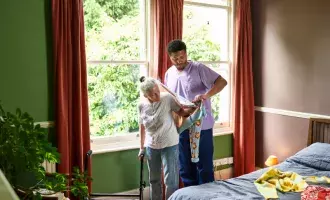Our changing shopping and working habits are reshaping the role of our town centres, and this shift has been rapidly accelerated by the Coronavirus pandemic.
Over the past few months, we’ve seen major brands such as Debenhams leave our high streets for good and others, like John Lewis, announce that they are closing shops. Councils are also finding that their buildings and land are underused or surplus to requirements.
To explore the challenges and opportunities facing our town centres, our property assets team hosted a virtual session at this year’s LCG Summit to discuss how councils can use their land and property to drive recovery.
Making town centres an experience-focused destination
Neil Darwin, Managing Director at Deyton Bell, which provides development consultancy services, explained that we’re seeing an industrial revolution on the high street. Traditionally town centres have been retail-led, but now that’s likely to become a secondary function as they change into leisure and experience-based destinations.
Neil said that, as more people work from home, they will want different things from their town centres: “The role of the evening economy will become even more vital everywhere. If we’re going to be cooped up a lot of the week indoors in our own property, we’re going to be looking to get out and the evening economy will become an even bigger factor.”
Robert Fleming, Director of Economic Assets at Capita, agreed that the blurring of uses in town centres to enable people to be active is going to be very important. He said that councils need to accept change and adapt their assets to become multi-functional, and he listed some that have done this.
He said: “This might be like The Forum in Norwich, where there are libraries and public services blended with retail, offices and events spaces. It could be the wholesale replacement of redundant shopping as proposed in Wolverton in Milton Keynes, where new apartments will replace a shopping centre and car park. Or like in Stockton-on-Tees, where they are building a new city park and civic centre by 2022, having bought out a shopping centre.”
Robert explained that councils must start thinking about their assets in new ways, and they often have access to a range of funding options that offer greater flexibility. He said: “Every asset needs an action plan, with targets and milestones, that forms your in-tray every working week, because we must be proactive going forward if we’re going to succeed.”
Growth in action in Barnet
Barnet is London’s biggest borough by population, with more than 400,000 residents and 30 different town centres. Stephen McDonald, Director of Growth at Barnet Council, explained how it’s running different schemes in six town centres to unlock the value of its assets and “promote regeneration to support communities”.
Stephen explained that the council can drive growth by using its planning powers, covenants, the land it owns such as car parks and libraries, and its ability to buy new property.
In total, Barnet Council is building more than 20,000 homes and 1m square feet of commercial space. One such project is in Hendon. Suzi Carter, Head of Asset Acquisitions at Barnet Council, explained that there are several buildings in Hendon town centre that are almost obsolete. The council worked closely with the local university to turn them into student accommodation and academic offices. It was awarded One Public Estate funding to contribute to the project. However, for it to be financially viable, the council needed to look at different options.
Suzi said: “If we had gone down the traditional development partner route, the viability wasn’t great, so we had to be more inventive and creative. The way we have struck a deal with the university is with long leases, based on their covenant strength.”
Suzi explained that the council has a couple of funding options for the scheme: “One is the traditional public work loan board route. The second is via private finance with a pension fund, or group of pension funds, who would be interested in either the university’s covenant or the council’s covenant if that was on offer. The difference between what we would get from the property yield for the land and buildings versus the covenant route is significant and makes the viability extremely attractive.”
The thought-provoking session highlighted how councils need to explore a range uses for the assets that they own and think creatively about the funding options for regeneration. The discussion that followed focused on the role that tourism can play in the town centres of the future, both for retaining local people in the area and attracting new visitors.
Neil said: “Tourism has to be a key part of creating an experience but play to your area’s strengths and offer something that is different from everywhere else.”
To find out more about we can help you to manage your assets so that they drive growth, contact localpublicservices@capita.co.uk.







